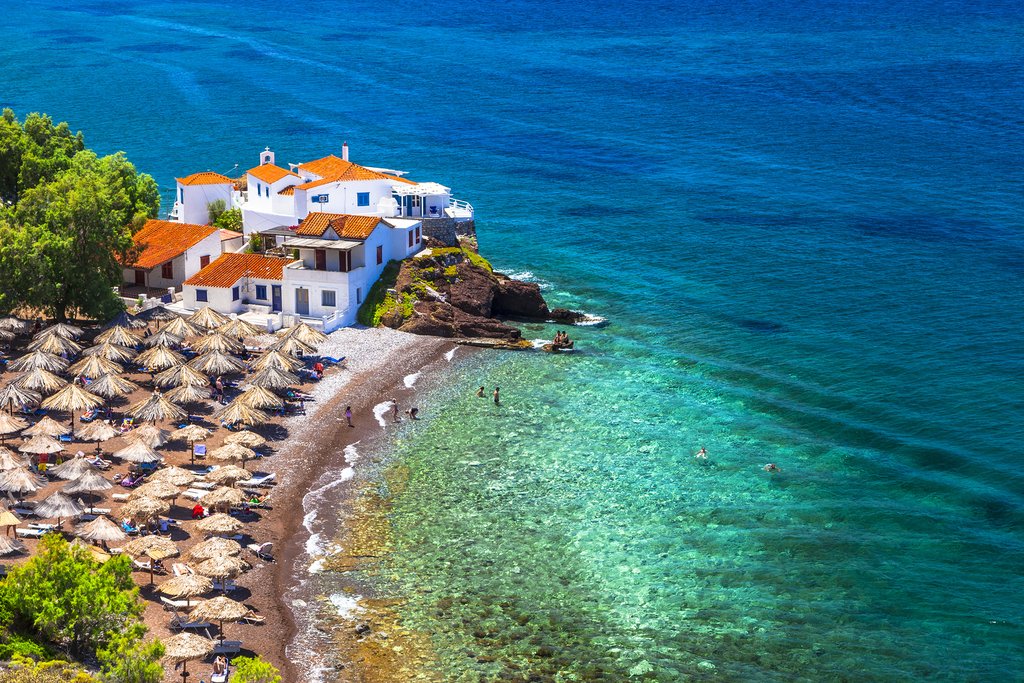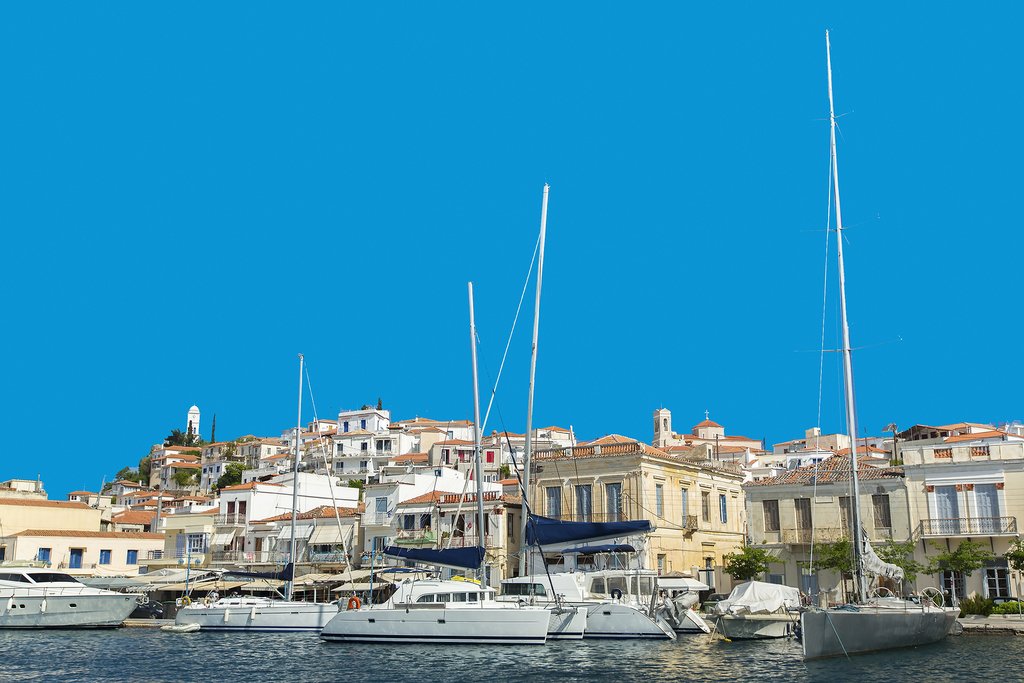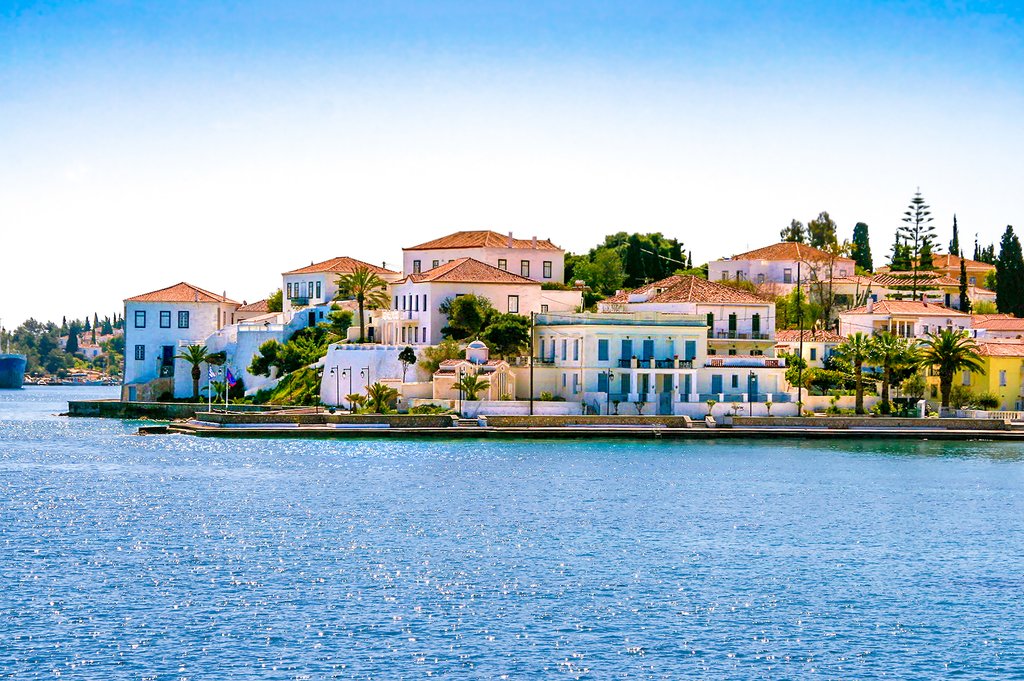Discovering the Saronic Islands
A popular weekend destination among Athenians, the rocky, partly volcanic Argo-Saronic Islands are the closest group to Athens. Each has a unique landscape and ambience—Aegina with its ancient temples, Poros and its pine-studded hills, and barren Hydra with its horse-filled streets. You won't want to miss affluent Spetses, the furthest from Athens, with its whitewashed neoclassical homes and turquoise coves.
The Saronics are close enough to Athens for day-tripping. Even so, take our advice and combine several of them for a multi-day vacation or weekend break from the capital city. Our experts organize the perfect itinerary for you. Want more info? Find inspiration with our Ultimate Guide to Island Hopping in Greece.
Getting There & Around

The Saronics are served by regular car/passenger ferries and faster hydrofoils, with five routes and more than 40 daily departures from the Port of Piraeus in Athens. Three ferry companies—Anes Ferries, Hellenic Seaways, and Saronic Ferries—offer service, and it’s easy to combine two or more islands in one day.
Regular ferries from Piraeus to Aegina take 1 hour 15 minutes and connect with the neighboring isle of Agistri. The once-a-day direct ferry from Piraeus to Agistri takes two hours; hydrofoils make the journey in half the time. It takes three hours by once-a-day ferry to Poros, while hydrofoils depart almost hourly in high season; both ferry and hydrofoil connect Poros to other isles. Hydrofoils (but not ferries) to Hydra depart up to five times daily for Poros and take two hours; likewise, Spetses is served solely by hydrofoil (3 hours).
Water-taxis and ferries also connect some islands to the Peloponnese mainland, and Poros and Spetses are linked by ferry to the Cycladic Islands. This website provides an up-to-date schedule.
Chat with a local specialist who can help organize your trip.
When to Go

The most popular months are July-September, which guarantees the sunniest weather but also draws the most visitors. The islands are best visited in the shoulder season—late spring or early autumn—when the crowds thin and rates drop. Mid-week is also best, as the islands' proximity to Athens means that weekenders pour off the ferries come Friday. Easter is best avoided as well. Almost every Athenian family tries to get away for this holiday weekend and the Saronics are the easiest option. Read more about the Best Time to Visit Greece.
Saronic Islands in a Nutshell
Despite their similarities (they were all under Venetian occupation until 1718), each island is as distinct as a thumbprint. As you head around the Peloponnese peninsula, the three most popular isles—Poros, Hydra, and Spetses—become more upscale and expensive. The following are in geographic order as you progress south from Athens.
Aegina: Laidback & Historic Local Retreat

As your ferry rounds northwestern Cape Plakakia you’ll be struck by the first views of the island's namesake town of Aegina. Its harbor is lined with restaurants and the skyline topped by the dome of the Orthodox Church of St. Nicholas (patron saint of sailors). On your left, you’ll see the remains of the once magnificent Temple of Apollo, today reduced to one partial column and some foundation stones.
More impressive is the great 5th-century BCE Temple of Aphaea, on the northeast side of the island. Perched atop a knoll, it’s an inspiring site that tempts you to linger for sunset. The temple has more than twenty Doric columns set against green groves of olives. Close by is the quaint resort town of Agia Marina.
Aegina is best avoided on weekends when it is thronged with Athenians, many of whom have second homes here. Still, it retains a seductive, laidback ambiance, best savored during midweek or out of season.
Where to Stay on Aegina: For sunset and sea views in a romantic classical style, you can’t top Rastoni Guest House, with its lovely garden at the heart of an old pistachio farm a short walk from town.
Agistri: Blissful Beach Escape on a Tiny Isle

This sparsely populated little isle, four miles west of Aegina, boasts some fine beaches and turquoise waters. It's perfect for an escape free of hordes of visitors. Hotels, restaurants, and bars line the north shore, beyond which the rocky isle is mostly pine-covered.
Where to Stay on Agistri: Nestled above a rocky cove with swimming platforms, Rosy’s Little Village is a tranquil haven with 17 simply furnished rooms and a restaurant utilizing fresh produce from the hotel’s own garden.
Methana: Lava Dome Hikes & Warm Ocean Swimming

A volcanic mass pushed up from the sea, Methana is today a peninsula connected to the Peloponnese mainland by a thin isthmus. Its steep slopes, rugged terrain, and lack of beaches set it apart from the other islands. There are more than 20 lava domes studding the landscape (the last eruption was in 230 BCE), and hikers will like ascending to the top of the volcano (capped by the simple Profitis Ilias church). Allow at least three hours from the resort town of Mathana. It’s three total miles follow a convoluted route along narrow asphalt roads with many sharp hairpins and unmarked bifurcations. A trail to the church is denoted roadside by a small chapel on a pedestal.
A century ago, Methana was a popular spa destination. Hot springs still seep into the harbor, south of which you can bathe in turquoise ocean waters warmed by the volcanic springs.
Poros: Lively & Walkable with Activities Galore

To Methana’s southeast, against the Peloponnese peninsula, this island is popular with yachters, package tourists, and (on weekends) Athenians. With its curving harbor backed by whitewashed houses rambling up the green hillside, lively Sferia (Poros town) has the cosmopolitan air of St. Tropez. Sferia’s must-see Archaeological Museum, on the south-facing waterfront Korizy Square, displays relics from ancient Troezene, the Temple of Poseidon, and other local sites (see below). The freestanding hilltop clocktower is popular at sunset, although more rewarding is to take the path to the Church of St. Athanasios for the most sensational panoramic vista.
A thin stretch of sand extends along the shore immediately north of Sferia, leading to Askeli, the largest and most popular beach. The big hotels are here, all within walking distance of town. A 20-minute walk east leads to little Monastiri Beach, which sits at the base of a forested hill. A five-minute uphill hike leads to the lovely 18th-century Monastery of Zoodochos Pigi. Pay a visit for the wooden iconostasis gilded with frescoes. The rest of the island is sparsely populated and covered in pines, the aroma of which fills the air.
The sole archaeological site here is the meager remnants of the Temple of Poseidon, built in 520 BCE and sacrilegiously dismantled in the 18th century. You can take a water taxi to the Peloponnesian town of Galatas, from where it’s a 45-minute taxi ride to ancient Epidavros, with its stunning theater. Tour operators in Sferia also offer excursions. An interest in antiquities may inspire a visit to the remains of ancient Troezene—once a powerful city—located outside the mountain village of Trozina, five miles west of Galatas.
Where to Stay on Poros: There’s nothing not to like about the Dimitra Blue Hotel, a boutique adorned in classic Greek whites and blues. Located on the north side of Sferia, it has a rooftop garden terrace perfect for enjoying sundowner cocktails. If you prefer a beach location, choose the New Aegli Hotel, a bargain-priced four-star option overlooking Askeli beach.
Hydra: Ouzo, Hills, and Not a Car in Sight

Rounding the Peloponnese peninsula you reach quixotic Hydra, in the Argolic Gulf. Long and slender and oblong, this barren and waterless isle is almost all rock. Despite its large size, the only transport here is donkeys (Hydriots feel the same about gas-powered wheels as do the Amish do). Even bicycles are banned.
This showcase island is riveting when viewed from the water. You'll see its tiny harbor—a perfect horseshoe—backed by 18th-century mansions tucked into a natural amphitheater. Its labyrinth of steep, narrow, marble streets adds glamour, making Hydra a trendy destination for yachtsmen and moneyed bohemians. There’s no better place to laze the day away sipping ouzo and coffee, playing backgammon with locals, and savoring the steady buzz of cicadas and bouzouki music.
Water-taxis can run you to Hydra's few pebbled beaches. The waters are gorgeous, and the virtually uninhabited interior offers solid hiking (except in the airless heat of midsummer). An easy option is the zigzagging, three-mile round-trip path to the hilltop Moni Profiti Elia monastery. It has a huge library and even more expansive views.
Where to Stay on Hydra: Our top pick is the intimate and secluded six-room Phaedra Hotel. Tucked among the cobbled alleys of the old town, it makes up for its lack of sea views with an impeccable ambiance and superb breakfasts served on the shaded terrace.
Alternately, check into the Orloff Boutique Hotel, a recently refurbished former monastery. Inside you'll find the original wooden floors, frescoed wood ceilings, and antiques. You can breakfast on a patio garden shaded by citrus trees.
Spetses: Culture by Day, Party by Night

Most southerly of the Saronics, this teardrop island (famously the setting for John Fowle’s novel, The Magus) is the biggest party destination of them all. The affluent and historic old town (Dapia) of Spetses is home to whitewashed Venetian mansions, and the maze of streets rising inland boast many raucous cafés, restaurants, and bars. Spetses was once a major shipbuilding center, and a few grizzled carpenters still hew wooden boats in the traditional manner in the harbor.
While exploring the historic quarter, don’t miss the Bouboulina Museum, dedicated to the illustrious (and infamous) Laskarina Bouboulina, a heroine of the Greek War of Independence (1821-29). She's said to have acquired a series of husbands—or at least lovers—at pistol point. The museum occupies her former home. Nearby, another 18th-century mansion hosts the Spetses Museum, with exhibits tracing the island’s history back to the classical period.
Beyond town, this pine-forested island is almost entirely unpopulated. The coast Is ringed by a meandering road along which you'll find crystal-clear coves with pebble beaches. Our favorites include Zogeria, a small cove at the northwest tip of the island; Agia Marina, a one-mile walk from Dapia and featuring beach bars, tavernas, and watersports; and similarly populated Agia Anargiri, some seven miles west of town. Water-taxis will run you there.
Where to Stay on Spetses: The peerless Orloff Resort is a conversion of a 19th-century Venetian mansion updated with a contemporary design. It has a swimming pool surrounded by olive trees—the perfect place for breakfast. The owners also operate the gourmet Orloff Restaurant, a 15-minute walk away on the Dapia harbor wharf.
Spetses’ stateliest building is the French Riviera-style Poseidonion Grand Hotel, which opened in 1914. Now refurbished, it still defines Greek luxury and has a spa, art gallery, fashion boutique, and a choice of fine-dining restaurants.
Ready to start planning your trip to Greece? Check out these great tours and itineraries.
